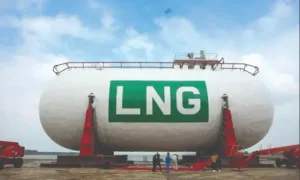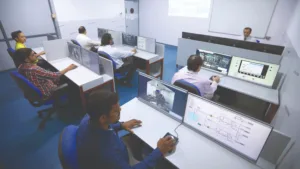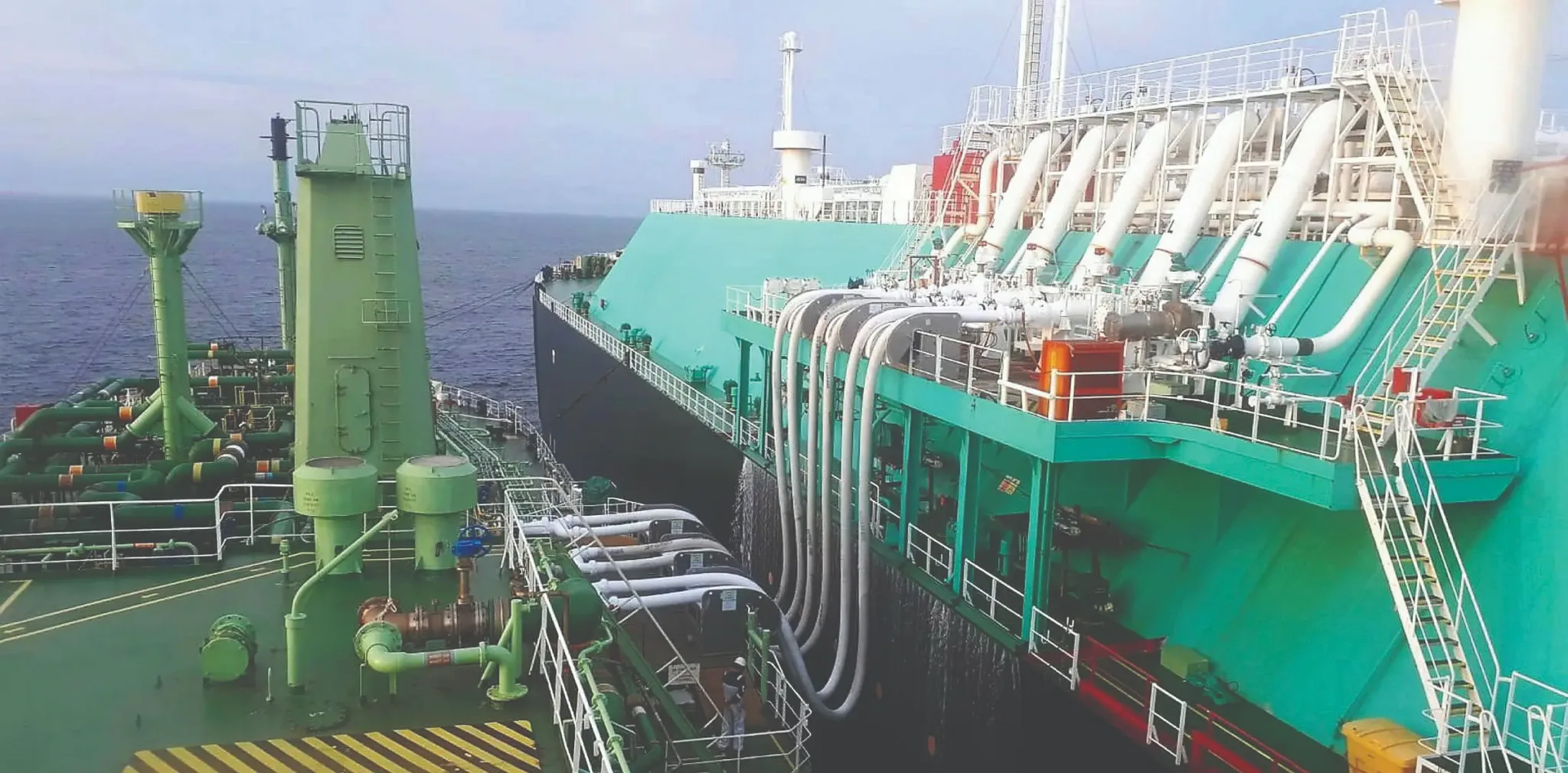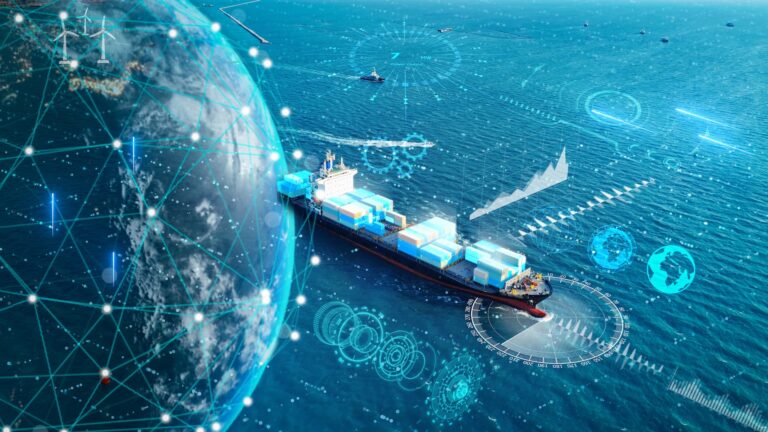On 10 August 2022, Anglo-Eastern Tanker Management (AETM) Hong Kong took delivery of the 109,999-dwt MT Proteus Jessica, the first LNG dual-fuel oil product tanker under our full technical management.
Proteus Jessica is the first of four LNG dual-fuel vessels commissioned by new client Bank of Communications Financial Leasing (BOCFL) to be completed and taken into AETM Hong Kong management in 2022, marking a proud moment for Anglo-Eastern and another step in the right direction for decarbonisation.
When fuelled solely by LNG, Proteus Jessica is fully IMO Tier III-compliant, capable of reducing emissions as follows:
- Carbon dioxide (CO2) – 23%
- Nitrogen oxides (NOX) – 90%
- Sulphur oxides (SOX) – 99%
- Particulate matter (PM) – 99%
VESSEL SPECIFICATIONS

Driving the low-emission profile of Proteus Jessica is a WinGD W6X62 DF (Tier III) engine and the latest power generator offerings by MAN Energy Solutions: Two MAN L28/32DF GenSets (Tier III), and one MAN L23/30H GenSet designed to run on low sulphur fuels (VLSFO/LSMGO) with a selective catalytic reduction system for reducing NOx emissions. Each generator is capable of generating 1,200 KW of power.
The fuel gas supply system comprises two LNG cryogenic storage tanks installed horizontally on deck, with the support of two saddles. The IGF Type C tanks are designed to store LNG bunker fuel at -163°C and are insulated to minimise boil-off. Each tank is fitted with two variable frequency drive controls and two vertical submerged fuel pumps capable of supplying 2,144 kg/hr of LNG to the fuel gas supply system.
LNG AS MARINE FUEL
Following the IMO’s tightening of SOX regulations in January 2020, most ocean-going vessels now use low-sulphur heavy oil or gas oil. However, while sulphur emissions are reduced by using such modified conventional fuels, they do not support decarbonisation efforts, so remain inadequate for achieving the IMO’s goal of reducing CO2 emissions by more than 40% in 2030 compared to 2008 levels.
For this reason, LNG is increasingly being viewed as the marine fuel of choice due to its low environmental impact. Specifically, advantages of using LNG include:
- Sulphur is already removed in the pre-liquefaction process, so it emits next to no SOX or particulate matter when burnt.
- By virtue of its composition, LNG emits less NOX and CO2 than other fossil fuels.
- Its specific gravity is lighter than air, making it easy to diffuse and thus no more risky to handle in open or well-ventilated areas.
- LNG reserves surpass that of oil, ensuring a stable, long-term supply for the next 50+ years.
As a result, orders for new LNG-fuelled vessels have taken off, reaching a record high in 2021, as shipowners look for near-term solutions to meet environmental regulations and improve the performance of their fleet. Indeed, some 240 LNG-fuelled vessels were ordered in 2021 alone, which is more than the previous four years combined.
The near- to mid-term outlook for LNG is thus brighter than that of any other fossil fuel due to its comparatively lower cost and lower emissions from production to combustion. Looking at overall emission levels, LPG and LNG are the only two fuels that can tide a diesel cycle dependent industry beyond the 2035 required emission targets.
Though hydrogen, ammonia and methanol have the lowest emission profiles, they fail to meet the 2020 emission intensity reference because of the high energy presently required to produce such alternative fuels. Until their sustainable production can be ensured, the industry will need to rely on LNG in the near- to mid-term, and LPG in the case of LPG carriers.
LNG BUNKERING PROCESS
LNG is a cryogenic liquid at temperatures of about -162°C (-259°F). As such, it is hazardous to personnel and any conventional steel structures or piping with which it comes into contact. Due to its unique properties, a different bunkering process is required compared to conventional marine fuels.
The vapour from conventional petroleum bunkering has a flash point above 60°C (140°F) and is simply vented through flame screens into the atmosphere. In contrast, LNG vapour can form explosive clouds in confined spaces that are considered hazardous. As a result, special handling of the bunkering vapour is required, such as the use of cryogenic transfer equipment, other safety and protective equipment, as well as specialised procedures.
As per the rules of the International Association of Classification Societies, all LNG-fuelled vessels must comply with the IGF Code and have an LNG Bunker Management Plan (LNG BMP). Essentially an ‘instruction manual’ for using LNG as fuel on board, this plan must comprise all safety aspects of LNG, including detailed procedures such as ship-specific process flow diagrams, etc.
The nearly 200-page LNG BMP for Proteus Jessica was prepared by our in-house LNG dual-fuel team of experts and approved by Lloyd’s Register.
Stationed in Singapore, our specialist team is dedicated to supporting our technical management units in the takeover and management of LNG dual-fuel vessels, and comprises experts with vast experience in the design modification, management, and operation of LNG vessels and floating storage and regasification units (FSRUs).
In the case of Proteus Jessica, the first bunkering operation was safely performed at the shipyard prior to departure in strict adherence with the LNG BMP. The plan was shared in advance with the crew of the bunker vessel to ensure a clear understanding of the required procedures, effective collaboration, and compliance.
CREW SELECTION AND TRAINING


Identifying the right individuals to crew a vessel and ensuring they receive the necessary training is always a priority – even more so in the case of Proteus Jessica, given the vessel’s status as Anglo-Eastern’s first LNG dual-fuel tanker. This is where our sizable pool of Indian gas carrier officers and crew proved advantageous, giving us the upper hand in identifying top performers best suited for the job.
A vessel-specific training programme was jointly developed between the AETM Hong Kong technical management unit in charge, our Singapore-based LNG dual-fuel team, and Mumbai crewing office. In order to obtain certification to sail, as required by the IGF Code, the master and all engineers had to complete both basic and advanced training, while the remaining officers had to complete basic training, and all crew needed to witness a physical LNG bunkering operation.
Engineers were further enrolled in engine-specific training at our Anglo-Eastern Maritime Training Centre (AEMTC) in Mumbai, which is approved by the engine manufacturer WinGD to conduct certified courses and simulator training on the various engine components, systems, and their functionality.
TAKEOVER
The original delivery schedule for Proteus Jessica was end of Q2 2022, but due to Covid-related lockdowns, the date kept getting pushed back, thus further complicating the already challenging process of working around China’s existing travel restrictions for foreign takeover crews.
Once the delivery date of August 10th was confirmed, the proven solution of appointing a Chinese crew to sail the vessel outside of China for the proper takeover was arranged. The interim crew, all accordingly certified, sailed Proteus Jessica to South Korea, where the similarly certified Indian crew were waiting to sign on and take the tanker to its first post-delivery bunkering port of Pengerang in Malaysia.
Throughout the process, from sea trials and delivery to crew familiarisation and LNG bunkering, our vessel manager was in attendance to ensure a smooth transition. Ironically, he endured anything but a smooth transition himself, having been subjected to two months of quarantine and lockdowns upon arriving in China. Despite this, the vessel manager was there at all critical stages of the process to guide the delivery, takeover crew, audits, and SIRE inspections.
The experience gained from Proteus Jessica has proven invaluable for all parties involved, including the interim Chinese crew, serving to ensure a smooth takeover of sister vessels MT Proteus Iwona on September 27th, MT Proteus Rebecca on October 24th, and MT Proteus Stephanie on November 16th.
Innovatng for a better maritime future
A key advantage that Anglo-Eastern derives from its global scale and clientele is the ability to observe industry trends as they develop, while getting deeply involved in various green projects. This breadth and depth of knowledge has served us well, and we have continued to build significant experience in the design, construction, and operation of dual-fuel vessels, which neatly dovetails with our commitment to decarbonisation and “shaping a better maritime future”.
We already manage two LNG dual-fuel ro-ro vessels and three LPG dual-fuel gas carriers, to which we can now add Proteus Jessica and, by year-end, three more sister LNG dual-fuel oil product tankers. At the same time, we are actively engaged with 50 vessels – across all ship types, either at sea or as newbuilding projects – that intend to use LNG, LPG, hydrogen or ammonia once these become viable, but which remain “dual-fuel” for the time being.
Anglo-Eastern Technical Services (AETS) has the rare distinction of having developed two novel ammonia dual-fuel vessel design concepts that were approved by Lloyd’s Register and ABS, making us the first independent ship management group to have developed zero-emission vessel designs for the future.
We have ramped up our training centres in India with the delivery of technology-specific courses and state-of-the-art simulators for future fuels in partnership with the main engine manufacturers, such as MAN, WinGD, and Wärtsilä TechSim. Our dual-fuel engine simulators are complemented by an LNG bunkering simulator aimed at familiarising crew with LNG bunkering procedures and the fuel gas supply system.
And we take this knowledge we have acquired to help guide our business partners on their own journeys towards decarbonisation. We do this with support from our dedicated environmental compliance and advisory team to our technical services unit, while imparting best practices and thought leadership on how to navigate the changes and challenges that lay ahead, as we all strive for the IMO’s vision of “sustainable shipping for a sustainable planet”.









